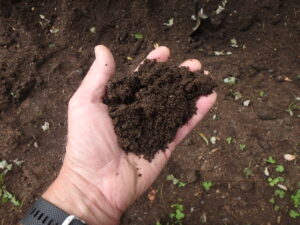Make Your Own Compost to Build Better Soils
Posted on Tuesday, September 7, 2021 · Leave a Comment
Most gardeners do some composting. Some folks compost anything that once was part of a living plant, often mixing it with barnyard waste; they turn and aerate their piles and make terrific compost in record time. Others are lazy composters who just throw kitchen scraps or weeds in a pile and let it slowly decompose over time, allowing it to gradually decompose. I’m a lazy composter. I have do much to do in the garden to take the temperature of my compost pile (though I have, actually) or check it weekly for moisture content – let alone turning it regularly.

Good compost is worth its weight in gold
Let’s look at the basics: organic matter – leaves, weeds, moldy broccoli or cow manure – is digested by bacteria and fungi. These microorganisms exist in amazing numbers in biologically active soil or compost. But for them to multiply and breakdown organic matter they need a good supply of materials containing lots of carbon and a little bit of nitrogen. Both are needed to build cell walls of the little critters and the proteins and oils in their bodies.
Scientists tell us that by weight, your compost pile should be 25 or 30 pounds of material containing carbon for one pound of nitrogen. Carbon-containing materials include dry grass or leaves, straw – and in general, brown materials. Nitrogen-containing things are also referred to as “green” materials – fresh grass clippings, weeds and household kitchen waste. Just to confuse you, all manures – which are brown – are also full of nitrogen.
We keep a 55-gallon drum of dry leaves next to our compost bin. We fill it in the fall and pack down the leaves to get in as many as possible. Each time we empty our 5-gallon bucket of kitchen scraps into the bin, we take some leaves and add them on top. This adds carbon to the pile, and helps a little to keep flies from finding the goodies. These leaves are certainly is not in the ratio of carbon to nitrogen we need for the fastest composting, but it helps. We count on the kitchen scraps to have some carbon, too.
For weeds, we just pile them up and let them decompose over time. We suffer from an infestation of goutweed, a noxious invasive. We try to keep any goutweed out of piles that will eventually be used for compost as even a scrap of root can start a new place for it to grow. Other invasives we do not have – but would separate if we had them include Japanese knotweed and black swallow wort. In fact, anything invasive should not go in any compost pile you hope to use later.
What else should stay out of compost piles? Meat scraps, oils and fat, dog and cat feces. Shredded newspapers and office paper can be used in compost piles – they are carbon-based, and their inks now are made from soy products. Shiny color inserts and magazines I avoid using. If you add shredded paper to your compost pile, mix it in well – thick layers will not decompose easily.
What about weed seeds in compost causing problems when you use your homemade compost? Ideally, if you are doing everything right, your compost pile will heat up enough for a few days to kill the weed seeds. That means curing it for three days at 140 degrees F. I ‘ve done experiments using annual grass seed and a soil thermometer, and found that even day or two at 135 will kill those seeds. Weed seeds may be tougher, of course. And it is tough to get an entire compost pile hot at the same time.
So how do you get your compost to heat up? You need to layer green (Nitrogen-containing) and brown (Carbon-based) materials. The key is the nitrogen layer. Fresh grass cuttings are high in nitrogen and easily collected with a bagger. Mix them in your compost pile, and it will heat up. Poultry manure, or any manure is also high in nitrogen and will heat up your pile if mixed in. Compost thermometers look like meat thermometers with a longer probe, and are sold at garden centers or on-line.
Moisture level is important for making compost. The pile should be neither dry nor soggy. A handful should feel about as moist as a squeezed-out sponge. I place tree branches underneath a new compost pile to help with drainage. Never put a pile where a roof dumps water.
Your compost should be well aerated. You want aerobic decomposition. So some gardeners turn and fluff their compost regularly, which will help with that.
I add compost to the planting holes for my tomatoes and kale, and work some in for everything, in fact. Why? Because even though I have great soil, compost gets oxidized, breaks down, and gets used up. Plants extract minerals from it. Beneficial bacteria and fungi use it to build their bodies. I try to keep my soil fluffy – roots do better in soil that is loose and aerated – and compost helps me to create that most desirable of soils: a nice loam.
Even though I make compost, I also buy it by the truckload. It is available from farms, garden centers and others. Ask for hot-processed, aged compost to avoid weeds.
There are no poor gardeners, just poor soil. Add compost, and perhaps a little organic fertilizer and you will have a “green thumb.” It takes time to make compost and build soils, which is why you should start now!
You may reach Henry at
henry.homeyer@comcast.net or PO Box 364, Cornish Flat, NH 93746. He is the author of 4
gardening books.



